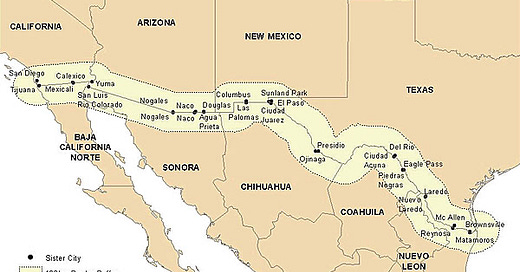The possibility of the United States invading Mexico used to seem unthinkable, but it is a subject of conversation among his cabinet picks. The question is not whether the military should be used against our southern neighbor, but when and how. https://www.rollingstone.com/politics/politics-features/trump-mexico-drug-cartels-military-invade-1235183177/
Of course the United States has a long history of military invasions and intervention in it, going back to our support for Americans who had settled in Texas and revolted against the government which had opened their doors to them. This was followed by our unprovoked war against Mexico in 1846, launched under dubious circumstances by President James K. Polk. It was a war that the future commander of Union Armies and President Ulysses S. Grant wrote:
Grant wrote later about the United States war against Mexico:
"For myself, I was bitterly opposed to the measure, and to this day regard the war, which resulted, as one of the most unjust ever waged by a stronger against a weaker nation. It was an instance of a republic following the bad example of European monarchies, in not considering justice in their desire to acquire additional territory.”
Grant had served as a junior infantry lieutenant under the command of General Zachary and fought in numerous battles while serving with the 4th Infantry Regiment, and he cited that war as one of the causes of the American Civil War.
The American invasion and victory forced Mexico to cede 55% of its territory to the United States. That includes California, Texas, Arizona, New Mexico, and parts of Nevada, and it created great animosity between the two countries that continues today. The tensions subsided, but the United States continued to interfere in Mexican matters, leading to a coup that overthrew the Mexican government and replaced it with one deemed more acceptable to the United States in 1913, but that was not enough and President Wilson withdrew his recognition of the Mexican government and urged other countries to do the same.
When Mexico sought weapons from abroad, Wilson took action. In 1914 he ordered an attack and occupation of Vera Cruz following the Tampico incident when 9 U.S. Navy sailors were arrested for entering a restricted area. They were released and the Mexican government issued an apology, but refused a demand from the American Naval commander to fire a 21 gun salute. Between that and the weapons shipment, Wilson ordered the occupation of Vera Cruz ans its custom House. After seven months the U.S. forces withdrew following the intervention of Brazil, Argentina, and Chile.
Between March 1916 and February 1917 the United States launched a punitive expedition along the border in response to raids by the Mexican revolutionary Pancho Villa. Despite the efforts of the Mexican President to defuse the situation it escalated and Brigadier General John J. Pershing began crush border operations to capture Villa. Eventually, the situation was resolved but led to more animosity.
The current situation is based on two major factors, immigration, now mainly of Central and South American refugees fleeing civil wars, drug cartels, and repressive governments, and the import of illegal drugs from Mexican drug cartels, which have been at war with each other and the Mexican government for decades. They are well armed with American weapons and have committed many assassinations and against Mexican government, military, and law enforcement officials, and atrocities against civilians. Trump blames the Mexican government and immigrants for the drug trafficking, but 90% of the people bringing drugs across the border are American citizens, however, the truth is unimportant to Trump and his minions. If darker skinned people can be blamed, they will be, at home and abroad.
Trump and his nominees for Secretary of State, Defense, and Homeland Security have all advocated using the military to attack or invade Mexico. Numerous ideas are being discussed, including using Special Forces kill Mexican leaders who resist, and other military options, not only against the drug, but against Mexican military and police units. South Dakota Governor, Kristi Noem, Trump’s nominee for Homeland Security stated:
"The United States of America is in a time of invasion -- the invasion is coming over the southern border. The 50 states have a common enemy -- that enemy is the Mexican drug cartels that are waging war against our nation. And the cartels are perpetrating violence in each of our states, even here in South Dakota."
Unfortunately, the real enemy are Americans whose addictions to illegal drugs cannot be satiated, and other Americans willing to bring those drugs across the border. However, that answer is not palatable to Trump, his minions, or those who voted for him. Americans are the innocent victims of dark skinned murderers.
So, with that in mind, let’s move the calendar forward to February, 2025.
Shortly after his inauguration on 20 January 2025, President Trump carried through on his promise to begin deporting millions of immigrants from the United States and ordered all government agencies to begin preparations for the action, and to help make it possible, Trump ordered the deployment of National Guard, Army Reserve, and active duty military units to begin the construction of concentration camps on the border with Mexico. When senior military officers objected, he fired the Joint Chiefs of Staff, the commander of U.S. Northern Command, and other high ranking officers who questioned the move, replacing them with officers deemed to be loyal to Trump who would have no qualms executing his orders. Likewise, officials in all Federal departments opposed to such actions were removed and replaced with people who would execute them to the letter.
While the camps were being built, DHS began contracting with civilian contractors to build permanent facilities, as the Justice Department began contracting with private prison corporations for more space. Likewise, DHS, Justice, and the Transportation Department began to contract with private bus and charter airline companies that would be able to provide the necessary transportation to move the detainees to the camps as a prelude to their deportation from the United States. Likewise, DOJ, DHS and Immigration and Customs officials began coordinating with state and local law enforcement agencies to begin the round ups of suspected illegal immigrants, additionally, Trump ordered the round up of legal immigrants working for American companies, like the Haitians living in Springfield, Ohio during the presidential campaign, as soon as possible.
In April the round ups began, while some states and municipalities refused to cooperate and appealed to the courts against the actions, most did not. Local police and sheriff’s whose union supported Trump provided their unconditional support.
However, all of those actions prompted diplomatic objections from Mexico, which promised that it would not support or allow the deportation of millions of people into its territory or across its borders. This further provoked Trump who now determined that he would launch a complex military campaign against Mexico.
Unfortunately for Trump, most Americans, even Republicans were against starting a war on our border, but, there was a way to persuade people to support an invasion. All that was required was a plausible scenario that would persuade Americans, regardless or their political affiliation to support the action. Thus, the administration began preparing for it, and Trump’s loyalists in the DHS, the Justice Department, and Federal intelligente agencies now under the control of Trump’s appointees devised a plan for the assassination of a major American political leader, and an attack on an important American landmark or institution. If Trump supporters were killed, it did not matter, nor did it matter if there was any involvement by the Mexican government, others could be found to carry out the attacks. While this was happening, Trump’s government and private propaganda machine began promoting stories of planned Mexican attacks on the United States, all of which were denied by Mexico.
By June the targets were selected, and the administration began mobilizing active duty and National Guard troops for duty on the southern border. Most of the active forces were based in Texas, or were from Special Operations Command, while National Guard units were from Texas and other Trump supporting states, including Arizon, Oklahoma, Kansas, Missouri, Arkansas, Louisiana, Mississippi, Alabama, Tennessee, Georgia, South Carolina, and Florida, as well as smaller states in the north with GOP majorities.
The administration continued to ratchet up the media coverage of alleged Mexican transgressions, and in August Congress adjourned for its Summer recesses and Trump retired to Mar a Lago where he was enjoying his golfing vacation. In attempt to lull the Mexicans and his American political opponents into complacency.
At 3;30 PM, 15 August, Texas Governor Greg Abbot finished an inspection tour of a camp near Eagle Pass, and went to the border to visit Texas National Guard, Texas Rangers, and other law enforcement officers on the border. Suddenly, in a supposedly secure area heavy gunfire erupted and Abbott fell mortally wounded. Several attackers were killed in the firefight, and the search for those responsible began.
About the same time bomb exploded at the U.S. Consulate in Matamoros. Two Marines and six security personnel were wounded, while 16 Mexicans waiting to process visas and entry permits were killed, and many more wounded. About the same time a suicide bomber struck the Alamo in San Antonio, killing six and wounding thirty tourists. President Trump, condemned the attacks and promised immediate military retribution, despite Mexico’s denials of involvement, and their promise of complete cooperation with the United States to track down the perpetrators.
However, all of the attackers were hired by agencies within the Trump Administration, and Trump had personally approved of the plans. The bodies of Abbott’s killers were identified as Mexican army special forces soldiers, which Mexico and its military vehemently denied. The attackers of the consulate were said to be members of the Gulf Cartel, while the suicide bomber at the Alamo was identified as an illegal alien with other drug cartel connections.
In the following days U.S. Special Forces personnel in Mexico assassinated, or severely wounded senior Mexican officials including, killing the Army Chief of Staff, several high ranking police and intelligence officials, and wounding Mexican President Claudia Scheinbaum. The Americans successfully escaped but the evidence collected by the Mexicans was undeniable. Both countries broke off diplomatic relations and on 1 September, American air, ground and naval forces began attacking Mexico. However, despite the overwhelming superiority of the Americans, the forces involved were hard pressed to advance much past the border regions.
In Ciudad Juarez, a critical city across from El Paso, the fight turned into a costly urban battle, and the operation stalled as regular Mexican forces withdrew into the interior and the well trained and equipped cartels began an insurgency campaign against the Americans, causing many casualties, and tying down troops now needed in Europe, Asia, and the Middle East, which were exploding in a way unanticipated by Trump or his advisers. The offensive stalled in the face of Mexican opposition and great logistical difficulties, especially the lack of spare parts for tanks and other vehicles.
Meanwhile, American consumers were hit with major price increases and inflation as Trump’s tariffs kicked into high gear and the agricultural products, medical equipment, care parts, and oil products provided by Mexico disappeared from the American market.
I will end the story for now, but as a historian, and as someone educated by the Marine Command and Staff College, and the National Defense University’s Joint Forces Staff College, were I also served as faculty, I do not think that this scenario is farfetched. I simply tried to imagine what might occur if Trump and his cabinet followed through with their threats against Mexico, while thinking about U.S. military capabilities and the probable ways that Mexico could resist. Having served in Iraq, and having watched the Russian invasion of Ukraine, I am no longer a believer in the effectiveness of “Shock and Awe” like I was back in 2003.
Until next time, I wish you all the best.






Germany 1920's to 1939 all over again . . . .